The ________ is a synergist of the latissimus dorsi; it extends, medially rotates, and adducts the humerus.
teres major
teres minor
supraspinatus
infraspinatus
tres major
________ is a powerful forearm extensor.
Triceps brachii
Brachialis
Biceps brachii
Brachioradialis
Triceps Brachii
Tennis players often complain about pain in the arm (forearm) that swings the racquet. What muscle is usually strained under these conditions?
the triceps brachii
the flexor digitorum profundus
the brachioradialis
the anconeus
the brachioradialis
The main forearm extensor is the __________.
coracobrachialis
brachilais
biceps brachii
triceps brachii
triceps brachii
Where are the origins of most of the muscles that move the fingers?
the wrist
the arm
the forearm
the palm of the hand
the forearm
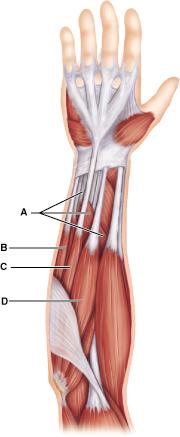
Which muscle provides a guide to the position of the radial artery at the wrist for taking the pulse?
A B C D
D between the tendons of flexor capri radialis and brachioradialis
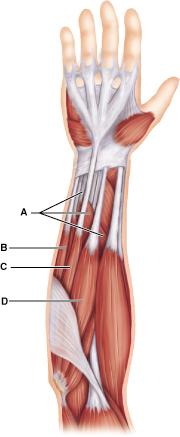
Identify the palmaris longus muscle
A B C D
C
All of the muscles that originate from the medial epicondyle of the humerus have one of two functions. Which of the following pairs is correct?
wrist flexion and forearm pronation
wrist flexion and supination
wrist extension and forearm supination
forearm flexion and wrist flexion
wrist flexion and forearm pronation
Paralysis of which of the following would make an individual unable to flex the thigh?
iliopsoas and rectus femoris
vastus medialis
soleus
biceps femoris
iliopsoas and rectus femoris
Which of the following muscles is involved in crossing one leg over the other to produce the cross-legged position?
the sartorius
the quadriceps femoris
all of the hamstrings
the gastrocnemius
the sartorius
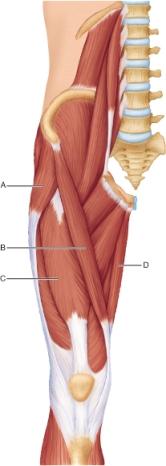
Which of the following letters represents the sartorius muscle?
A B C D
B
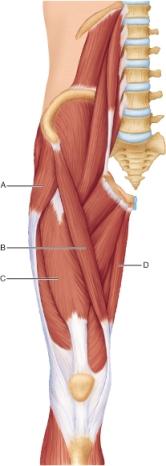
Which muscle would be a prime mover of knee extension?
C rectis femoris
Which of the following muscles is a flexor of the thigh?
adductor magnus
gluteus maximus
tibialis posterior
vastus lateralis
adductor magnus
Which muscle acts as both a knee (leg) extensor and hip (thigh) flexor?
rectus femoris
biceps femoris
vastus lateralis
gluteus maximus
rectus femoris
The anterior compartment of the thigh is involved in lower leg extension.True/False
True
The quadriceps femoris is composed of three "vastus" muscles and the ________.
semitendinosus
rectus femoris
semimembranosus
biceps femoris
rectus femoris

Which muscle is represented by the letter D?
gracilis
semimembranosus
semitendinosus
biceps femoris
biceps femoris
Which of the following muscles is NOT a member of the hamstrings group?
semitendinosus
semimembranosus
biceps femoris
vastus intermedius
vastus intermedius
Paralysis of which of the following muscles would make an individual unable to flex the knee?
brachioradialis
hamstring muscles
soleus
gluteal muscles
hamstrings
Which of the following is not a member of the hamstrings?
semitendinosus
semimembranosus
biceps femoris
gracilis
gracilis
Which of the following is a hamstring muscle?
biceps femoris
vastus medialis
rectus femoris
vastus lateralis
biceps femoris
Which of the following muscles is involved in inversion at the ankle joint?
tibialis anterior
fibularis (peroneus) longus
extensor digitorum longus
fibularis (peroneus) tertius
tibialis anterior
The ________ extends the great toe.
fibularis (peroneous) tertius
extensor hallucis longus
tibialis anterior
gastrocneumius
extensor hallucis longus
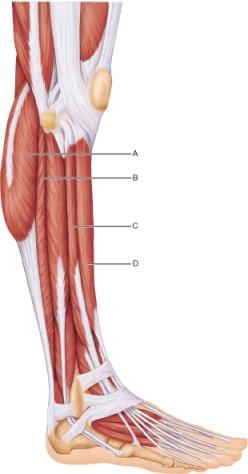
Which muscle is the prime mover of dorsiflexion?
A B C D
D tibialis anterior
Identify the extensor digitorum longus muscle. from the previous picture
A B C D
C
The soleus is a synergist of the gastrocnemius during plantar flexion.True/False
True
Which of the following muscles inserts to the posterior calcaneus via the calcaneal tendon?
the gastrocnemius
the tibialis anterior
the semitendinosus
the sartorius
the gastrocnemius
The insertion of the extensor carpi radialis longus muscle is on __________.
metacarpal one
metacarpal two
metacarpal three
metacarpal four
metacarpal 2
The insertion of the extensor digitorum branches into __________.
four tendons
two tendons
five tendons
three tendons
four tendons
The extensor hallucis longus muscle inserts on digit __________.
three
two
one
four
one
The anterior muscles of the thigh that originate on the os coxae are __________.
rectus femoris; vastus medialis
vastus lateralis; vastus medialis
sartorius; vastus medialis
sartorius; rectus femoris
sartorius; rectus femoris
The interosseous membrane is located between the __________.
radius and ulna
humerus and radius
humerus and ulna
ulna and the carpal bones of the wrist
radius and ulna
Which muscle of the wrist and fingers is a deep anterior flexor?
palmaris longus
flexor pollicis longus
flexor carpi ulnaris
flexor digitorum superficialis
flexor pollicis longus
Which superficial flexor muscle of the forearm is the most lateral?
flexor carpi ulnaris
flexor carpi radialis
flexor digitorum superficialis
palmaris longus
flexor carpi radialis
The palmaris longus inserts on the __________.
palmar aponeurosis
bases of the second and third metacarpals
bodies of phalanges 2-5
medial epicondyle of the humerus
palmar aponeurosis
Which muscle is a superficial anterior flexor muscle?
flexor digiti minimi brevis
flexor digitorum profundus
flexor pollicis longus
flexor digitorum superficialis
flexor digitorum superficialis
The two muscles that insert on the fifth phalanx or on the fifth metatarsal are the __________.
extensor digitorum longus and fibularis longus
fibularis longus and extensor hallucis longus
fibularis tertius and extensor hallucis longus
extensor digitorum longus and fibularis tertius
extensor digitorum longus and fibularis tertius
The extensor muscle that branches to form four tendons on the back of the hand is the __________.
extensor carpi radialis brevis
extensor carpi radialis longus
extensor digitorum
extensor ulnaris
extensor digitorum
The prime mover of wrist extension is the __________.
extensor digitorum
extensor carpi radialis longus
extensor carpi ulnaris
extensor carpi radialis brevis
extensor digitorum
Which of the following statements about muscles of the forearm is true?
Contraction of the pronator quadratus and the supinator results in forearm pronation.
The pronator quadratus is a two-headed muscle.
The pronator quadratus originates on the radius and inserts on the ulna.
The pronator teres originates on the medial epicondyle and inserts on the radius.
The pronator teres originates on the medial epicondyle and inserts on the radius.
Forearm supination is assisted by the __________.
supinator
brachioradialis
biceps brachii
triceps brachii
biceps brachii
The medial muscles of the hip joint that insert on the linea aspera are the __________.
pectineus, adductor magnus, and adductor longus
gracilis, adductor magnus, pectineus, and adductor longus
adductor magnus, adductor brevis, and pectineus
adductor magnus, adductor brevis, and adductor longus
adductor magnus, adductor brevis, and adductor longus
The muscles that extend the forearm are located __________.
laterally
anteriorly
posteriorly
medially
posteriorly
The two heads of the biceps brachii muscle come together distally to insert on the __________.
deltoid tuberosity
ulnar tuberosity
radial tuberosity
styloid process of the radius
radial tuberosity